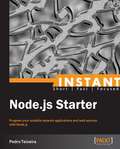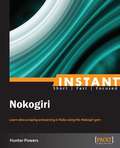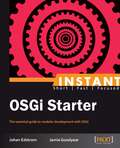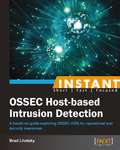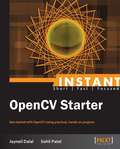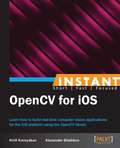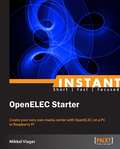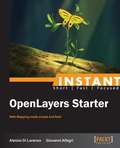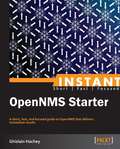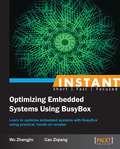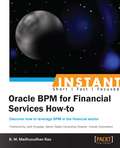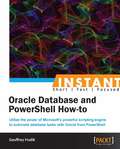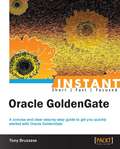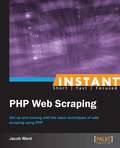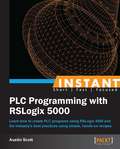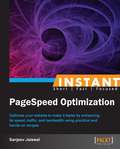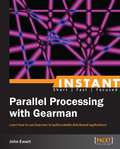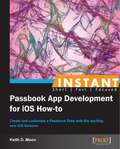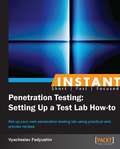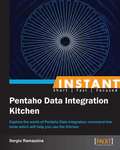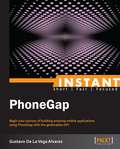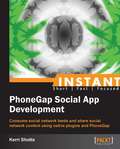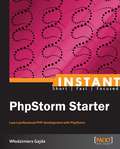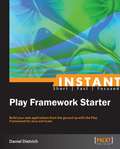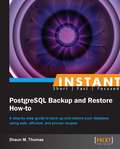- Table View
- List View
Instant Node.js Starter
by Pedro TeixeiraGet to grips with a new technology, understand what it is and what it can do for you, and then get to work with the most important features and tasks. A simple and easy-to-follow starter approach will help guide the readers through how to develop a real-time web application using Node.js with the help of a sample project.Instant NodeJS Starter is great for web developers who know JavaScript and are curious about Node.js and want to understand and be able to quickly start creating their first applications on it. This book is also recommended for people with experience in network programming and event-driven programming to be able to get started using this exciting technology.
Instant Nokogiri
by Hunter PowersGet to grips with a new technology, understand what it is and what it can do for you, and then get to work with the most important features and tasks. A concise, illustrated guide to extracting information available on the Internet using Nokogiri."Instant Nokogiri" is the perfect choice for the aspiring Ruby developer looking to incorporate screen scraping and parsing technology in their applications. Beginner level Ruby, basic HTML, and CSS experience is suggested.
Instant OSGi Starter
by Jamie Goodyear Johan EdstromUsing a practical approach with explanation where needed, the book will take an in depth look at what OSGi is and what it offers to Java programmers and development standards. "OSGi Starter" is intended for the senior Java programmer whom will be joining OSGi based projects, or for Architects looking to broaden their exposure to OSGi as a beneficial framework and runtime software system.
Instant OSSEC Host-based Intrusion Detection
by Brad LhotskyFilled with practical, step-by-step instructions and clear explanations for the most important and useful tasks. A fast-paced, practical guide to OSSEC-HIDS that will help you solve host-based security problems.This book is great for anyone concerned about the security of their servers-whether you are a system administrator, programmer, or security analyst, this book will provide you with tips to better utilize OSSEC-HIDS. Whether you're new to OSSEC-HIDS or a seasoned veteran, you'll find something in this book you can apply today!This book assumes some knowledge of basic security concepts and rudimentary scripting experience.
Instant OpenCV Starter
by Sohil Patel Jayneil DalalGet to grips with a new technology, understand what it is and what it can do for you, and then get to work with the most important features and tasks.A practical, quick, and hands-on guide for Python developers and hobbyists who want to get started with computer vision with OpenCV.This book is great for developers, hobbyists, and students new to computer vision who are looking to get a good grounding in how to use the OpenCV library. It's assumed that you will have some basic experience in C/C++ programming.
Instant OpenCV for iOS
by Kirill Kornyakov Alexander ShishkovFilled with practical, step-by-step instructions and clear explanations for the most important and useful tasks. This book uses a very practical approach, with each recipe and their associated sample projects or examples focusing on a particular aspect of the technology.This book is intended for OpenCV developers who are interested in porting their applications to the iOS platform. Basic experience with OpenCV, computer vision, Objective C, and other iOS tools is encouraged.
Instant OpenELEC Starter
by Mikkel ViagerGet to grips with a new technology, understand what it is and what it can do for you, and then get to work with the most important features and tasks. A tangible and easy-to-follow guide on installation and basic configuration of a home media center, allowing for the completion of the process without having to look elsewhere for additional information, and within a relatively limited timespan.This book is great for anyone with basic computer skills who is looking to get a good understanding of the OpenELEC installation process on a PC or Raspberry Pi. It is a great shortcut for experienced users to get tips and tricks, and also covers many topics of interest for all XBMC users on any platform. Readers are expected to know how to download, install, and use programs, as well as how to complete simple tasks such as unzipping compressed archives.
Instant OpenLayers Starter
by Giovanni Allegri Alessio Di LorenzoGet to grips with a new technology, understand what it is and what it can do for you, and then get to work with the most important features and tasks.A quick and simple Starter to working with the OpenLayers JavaScript library architecture, helping you become productive with it in a very short time.Instant OpenLayers Starter is a book for web designers or GIS specialists with a basic knowledge of JavaScript, for learning how to create simple, embedded, and basic maps, or to build complex data analysis and data management RIAs.
Instant OpenNMS Starter
by Ghislain HacheyGet to grips with a new technology, understand what it is and what it can do for you, and then get to work with the most important features and tasks. A starters' guide to learning OpenNMS with ease, with a focus on immediate results.Instant OpenNMS Starter is for network administrators of any level with a slight focus on the novice that would enjoy a swift glance at what OpenNMS has to offer. It assumes the reader will have knowledge of basic network operations and protocols such as the Internet Protocol Suite.
Instant Optimizing Embedded Systems using Busybox
by Wu Zhangjin Cao ZiqiangFilled with practical, step-by-step instructions and clear explanations for the most important and useful tasks. A step-by-step guide which provides concise and clear recipes for getting started with Busybox.If you are an embedded system developer or Android developer who wishes to learn to build an embedded (Android Linux) system from scratch, as well as to optimize the system performance, then this book will be great for you. It's assumed that you have some experience in Linux and UNIX utilities. If you are a new developer, this book will also help you to get started with Busybox and Android Linux development.
Instant Oracle BPM for Financial Services How-to
by B. M. RaoFilled with practical, step-by-step instructions and clear explanations for the most important and useful tasks. This book is a practical Packt How-to guide that is designed to provide targeted information for experienced BPM professionals in the financial sector.This book will be ideal as a pocket guide for people working with BPM for financial services. It is a short reference for financial analysts, business process owners, process participants, business process developers, and SOA and BPM architects and developers.
Instant Oracle Database and PowerShell How-to
by Geoffrey HudikThis How-To guide is full of hands-on examples to get your databases automated in no time, with easy to follow code that will prove useful time and time again. If you are a .NET developer using an Oracle Database or a regular Oracle Database user this book is full of helpful hints and tricks to automate Oracle Databases with Powershell.
Instant Oracle GoldenGate
by Tony BruzzeseFilled with practical, step-by-step instructions and clear explanations for the most important and useful tasks. Get the job done and learn as you go. A how-To book with practical recipes accompanied with rich screenshots for easy comprehension.This is a Packt Instant How-to guide, which provides concise and clear recipes for performing the core task of replication using Oracle GoldenGate.The book is aimed at DBAs from any of popular RDBMS systems such as Oracle, SQL Server, Teradata, Sybase, and so on. The level of detail provides quick applicability to beginners and a handy review for more advanced administrators.
Instant PHP Web Scraping
by Jacob WardFilled with practical, step-by-step instructions and clear explanations for the most important and useful tasks. Short, concise recipes to learn a variety of useful web scraping techniques using PHP.This book is aimed at those new to web scraping, with little or no previous programming experience. Basic knowledge of HTML and the Web is useful, but not necessary.
Instant PLC Programming with RSLogix 5000
by Austin ScottFilled with practical, step-by-step instructions and clear explanations for the most important and useful tasks. This is a Packt Instant guide, which provides concise and clear recipes to create PLC programs using RSLogix 5000.The purpose of this book is to capture the core elements of PLC programming with RSLogix 5000 so that electricians, instrumentation techs, automation professionals, and students who are familiar with basic PLC programming techniques can come up to speed with a minimal investment of time and energy.
Instant PageSpeed Optimization
by Sanjeev JaiswalFilled with practical, step-by-step instructions and clear explanations for the most important and useful tasks. Instant PageSpeed Optimization is a hands-on guide that provides a number of clear, step-by-step exercises for optimizing your websites for better performance and improving their efficiency.Instant PageSpeed Optimization is aimed at website developers and administrators who wish to make their websites load faster without any errors and consume less bandwidth. It's assumed that you will have some experience in basic web technologies like HTML, CSS3, JavaScript, and the basics of networking, as well as knowing how to edit Apache configuration.
Instant Parallel processing with Gearman
by John EwartGet to grips with a new technology, understand what it is and what it can do for you, and then get to work with the most important features and tasks. This is a quick tutorial allowing you to quickly increase the efficiency of your system by intelligently reducing its workload where possible and learn techniques for designing your solutions to take advantage of Gearman's architecture.The technology covered in this book is usable by almost any modern programming language and any type of application, be it web, desktop, or mobile applications.This book targets developers who are interested in adding distributed data processing to their applications. The examples in this book are written using Ruby, but are documented thoroughly to allow developers comfortable with other languages to understand how to use them in a language of their choice. Intermediate programmers with no previous experience in distributed computing will also be able to easily follow the content.
Instant Passbook App Development for iOS How-to
by Keith D. MoonFilled with practical, step-by-step instructions and clear explanations for the most important and useful tasks. A step-by-step guide, focusing on simple projects to help you create a Passbook app for iOS 6.Instant Passbook App Development for iOS 6 How-to is for registered Apple iOS developers, experienced in building an app using Objective-C and Xcode, looking to add Passbook functionality to their app. You will need to have an understanding of the JSON format, REST APIs, and a server-side language like Ruby. Familiarity with executing commands via the Terminal app is expected for the exercises within this book.
Instant Penetration Testing: Setting up a test lab How-To
by Vyacheslav FadyushinFilled with practical, step-by-step instructions and clear explanations for the most important and useful tasks. Get the job done and learn as you go. A how-To book with practical recipes accompanied with rich screenshots for easy comprehension.This is a How-to guide, written with practicality in mind. Theory is downplayed, and we get you started doing the things you need to do, right away. "Instant Penetration Testing: Setting Up a Test Lab How-to" is written for beginners to penetration testing, and will guide you in avoiding the common mistakes that people new to penetration testing make.
Instant Pentaho Data Integration Kitchen
by Sergio RamazzinaFilled with practical, step-by-step instructions and clear explanations for the most important and useful tasks. A practical guide with easy-to-follow recipes helping developers to quickly and effectively collect data from disparate sources such as databases, files, and applications, and turn the data into a unified format that is accessible and relevant to end users.Any IT professional working on PDI and is a valid support for either learning how to use the command line tools efficiently or for going deeper on some aspects of the command line tools to help you work better.
Instant PhoneGap
by Gustavo De AlvarezGet to grips with a new technology, understand what it is and what it can do for you, and then get to work with the most important features and tasks. This is a guide that starts with the basics of a PhoneGap mobile application along with top features to enable you to build your own PhoneGap mobile application.This book is ideal for those who want to develop mobile apps but do not want to learn a new SDK for every phone on the shelf. You should have basic knowledge of HTML5, JavaScript, and CSS or any programming language.
Instant PhoneGap Social App Development
by Kerri ShottsFilled with practical, step-by-step instructions and clear explanations for the most important and useful tasks. Get the job done and learn as you go. This book is concise and follows a clear, step-by-step tutorial approach. You'll need to have a desire to learn about mobile application development. Since Phonegap uses HTML, CSS, and Javascript heavily, it is important to have a good understanding of these topics. You should also have a good understanding of your desired platform and corresponding SDK and IDE (that is, if you want to develop for Android, you should be familiar with Eclipse. For iOS, you need to be familiar with Xcode.)
Instant PhpStorm Starter
by Wlodzimierz GajdaGet to grips with a new technology, understand what it is and what it can do for you, and then get to work with the most important features and tasks.This is a Starter book with plenty of coded examples and pictorial illustrations.If you are a developer who knows the basics of PHP and want to learn the PHPStorm and Symfony 2 frameworks, this book is for you. The book concentrates on using the IDE and not on the PHP language.
Instant Play Framework Starter
by Daniel DietrichGet to grips with a new technology, understand what it is and what it can do for you, and then get to work with the most important features and tasks.A practical, quick, and hands-on guide to the Play Framework.This book is written for readers interested in developing web applications with Java or Scala. A basic knowledge of either Java or Scala is helpful. Prior experience with Play is not required.
Instant PostgreSQL Backup and Restore How-to
by Shaun M. ThomasFilled with practical, step-by-step instructions and clear explanations for the most important and useful tasks. This hands-on guide provides a quick and easy way to back up and restore your database using PostgreSQL.Written for database administrators who want to create backups of their critical enterprise data and efficiently restore it using PostgreSQL.
